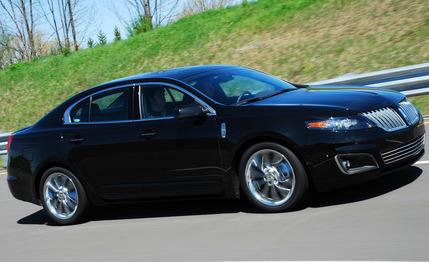 Short Take Road Test
Short Take Road Test

The arrival of the MKS sedan last year spurred hopes that it might revitalize Ford’s historically uncompetitive luxury brand, helping Lincoln to better compete with Cadillac, Lexus, and other aspirational marques. Most of the hype stemmed from the stunning MKR concept that debuted at the 2007 Detroit auto show; it floated the idea that future Lincolns wouldn’t be dowdy, livery-service specials like the current Town Car.
As it turns out, the MKS is indeed light-years beyond that ancient Panther-platformed barge in both styling and performance. But the production 2009 MKS came to market lacking the MKR’s exaggerated proportions, rear-wheel-drive chassis, and twin-turbocharged V-6—which then carried the aggressive TwinForce moniker. The reality of the MKS’s front-wheel-drive foundation (shared with the Ford Taurus) and naturally aspirated, 3.7-liter V-6 making 275 hp and 276 lb-ft of torque put it at a disadvantage with more powerful luxury sedans.
But Ford is now upping the big Lincoln’s game, as it will finally be available with a twin-turbo, 3.5-liter V-6 when the 2010 model arrives in showrooms in mid-summer. Although the engine carries the more marketing-friendly EcoBoost name, its 355 hp and 350 lb-ft of torque are for real and give the Lincoln the gusto to run with most V-8s. We recently had the chance to sample the new turbocharged model—as well as the 2010 MKT crossover—at Ford’s Michigan proving ground, where the company had a V-8 Cadillac STS and Infiniti M45x on hand for comparison.
Movin’ On Up
Supported by standard all-wheel drive and a beefier six-speed automatic transmission with paddle shifters and revised gear ratios, the EcoBoost MKS proved to be a far more compelling vehicle to pilot than the base car. However, it should be noted that, although the Lincoln handily outpaced the Cadillac and Infiniti in acceleration, technology, and refinement, Ford conveniently chose two of the oldest and least powerful vehicles in the segment for comparison.
With peak torque available as low as 1500 rpm, the direct-injected EcoBoost V-6 is flexible in its power delivery and motivates the near-4500-pound MKS with uncanny ease. Compared with the non-EcoBoost MKS—which takes 7.5 seconds to reach 60 mph and covers the quarter-mile in 15.7 at 90 mph—the twin-turbo car is a rocket. Away from Ford's proving grounds and on our test track, acceleration was smooth and linear up to the 134-mph top speed, with 60 arriving in 5.4 seconds and the quarter in 14.1 at 100 mph. Turbo lag is nonexistent and the exhaust note is hushed but noticeable, with a subdued growl that never gives the impression the engine is being worked too hard.
Although the prodigious low-end grunt tops that of many V-8s, Ford says the EcoBoost engine’s direct injection, compact turbochargers, and smaller displacement allow it to sip fuel like a proper V-6. Our short stint behind the wheel, with the throttle frequently contacting the floorboard, didn’t give us much of an idea about real-world economy. Still, the EcoBoost MKS’s city/highway mileage of 17/25 mpg beats the EPA figures for the STS and M45x—again, conveniently—which are rated at 15/22 and 14/20, respectively. The front-wheel-drive, 3.7-liter MKS is rated the same as the EcoBoost model; the all-wheel-drive base car gets 16/23 mpg. However, the Lexus GS460 with its 342-hp, 4.6-liter V-8 matches the economy of the boosted MKS, and the more powerful—and less expensive—Hyundai Genesis V-8 manages 1 mpg better on the highway. Although the Lincoln’s ratings are surely influenced by its porky curb weight and have yet to be verified by the EPA, we think it might have been better had Ford kept the cooler-sounding TwinForce name if the primary benefit of EcoBoost is performance.